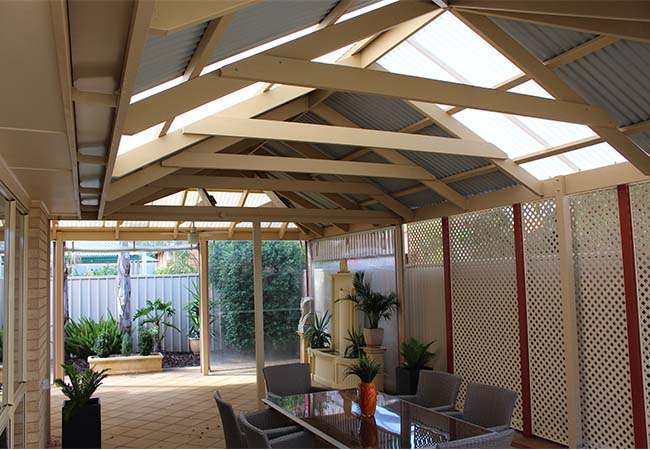GUTTERS
Whilst the primary aim is to collect and discharge water from your roof, gutters may also enhance your home's street appeal.
There is an extensive range of gutter profiles and material finishes.The most commonly used finishes are pre-painted "Colorbond" steel or un-painted "Zincalume" steel.
Bluescope Steel currently have twenty two colours to select from in their standard "Colorbond" steel range.
Gutter types.
Gutters fitted to the outside of the fascia boards are commonly called "Eaves" gutters.
Eaves gutters are manfactured in a wide range of profiles and material finishes. Some profiles are suited to both older style and modern homes whilst others are more suited to a specific application.
When selecting a gutter profile for you home it is important to recognize that the gutter's base width and height of the back edge determine the gutter's capacity, not the height of the front edge.
Most gutters produced in South Australia have a higher front edge than back edge. The higher front helps to conceal the lower edge of the roofing material and prevent water from overshooting the gutter.
Common profiles are "D" and "OG" and they suit a variety of older style and new homes. Due to their popularity they usually cost a little bit less than other profiles.
Some gutter profiles are suited to specific applications. High front square profile gutters are generally used in conjunction with high rib roof profiles or "Spanish" style tiles.
Half round style gutters have been an Architect's favourite and are generally fitted on external brackets. Several manufacturers make a similar style gutter that features a flat back edge and uses internal gutter straps. Eliminating the external brackets reduces the installation cost but the internal gutter straps may trap leaves and impede the water flow.
Modern manufacturing processes mean that gutters can be produced in long lengths rather than the short (6 foot) lengths originally used. However handling and transport restrictions dictate that the maximum length for gutters is usually nine metres.
Some homes have concealed gutters and Federation Villas and symmetrical cottages often have sections of roofing sloping to a gutter in the middle of the roof - this type of gutter is commonly called a "Box" gutter.
Improving the gutters efficiency.
The size, number and position of the downpipes determine how efficiently a gutter discharges the water.
Increasing the number of downpipes is generally better than increasing the size of the downpipes, although larger downpipes may help leaf matter to flow through the offsets (bends) in the downpipe.
It is good practice to have two downpipes or a downpipe and an "overflow" outlet fitted to each "Box" gutter to provide a second outlet in the event the primary downpipe is blocked.
Overflowing gutters are frequently caused by a build up of leaf matter or other debris that has accumulated on the roof. If your home has overhanging trees or is prone to collecting leaves blown from adjoining properties it is important to check the gutters regularly and clean when required.
Gutter Guards
Whislt installing gutter guards may reduce the amount of leaf matter accumulating in the gutter, gutter guards have limited effectiveness. They may not prevent leaf matter that has broken down from passing through the mesh, nor do they prevent dust blown onto the roof from being washed into the gutter. And it's difficult to stop Pine Needles.
If gutters overflow regularly it may cause the fascia boards to rot. Remember the front height is generally higher than the back height so the gutter overflows on the back edge, between the fascia board and the gutter. Overflowing gutters, particularly "Box" gutters may cause extensive and expensive damage to your house.
Call us today if you want sound advice on gutter replacement.
Case Study

Objective
Gable verandahs attached to the house fascia often cause leaks between the gutter and the fascias, particularly in heavy rain. This occurs most often when the original “Eave” gutter has been retained and effectively becomes an internal “Box” gutter. The leaks generally show on the house fascia since almost all eaves gutters have a lower back edge height than front edge height
DownloadSolutions
The simplest solution is to add a downpipe or downpipes to the section of gutter between the house and the gable verandah.
However this may cause another problem if the downpipe cannot be connected to an existing stormwater drain – What to do with the water from the downpipe.
Another solution is to replace the existing “Eave” gutter with a specially folded “Box” gutter to increase the capacity of the gutter.
The new “Box” gutter should be made to suit the width between the house and verandah fascia boards, and with the sides extending up to the underside of the roofing materials.
The new “Box” gutter could also be made with “flanges” on each side that extend up the slope of the roofs on each side.
If the house has a tiled roof the flange on the house side could extend up to the first tile batten.
If the roofing on the gable verandah is screw fixed to the verandah fascia a new purlin may need to be installed behind the flange and the roofing screwed to the new purlin instead.
The value of adding the flanges would be negated if the flange was penetrated by the screw fixings.
Outcome
The probability of leaks caused by an overflowing gutter is drastically reduced.
However you should still check the box gutter regularly to ensure it is free from leaves, ball etc. that can act like a dam wall.